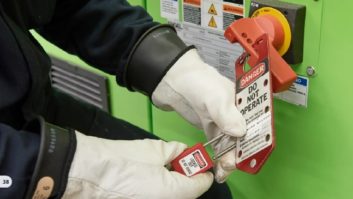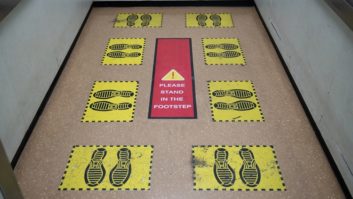Safety in the Workplace
Feb 1, 2013 2:00 AM, By Kevin McNamara
The nature of a typical broadcast operation has a variety of potential safety issues well beyond that of a typical office. Transmitter sites can be a safety nightmare if proper procedures are not implemented and followed. High voltages, shoddy electrical work, bypassed interlocks, working from ladders combined with exhausted personnel (because they were called in at 1 a.m.), typically working alone, is a potential accident waiting to happen. Tower climbing presents another potential hazard if not performed properly by trained personnel. Deaths resulting from falls from a tower, while decreasing each year, are still happening. While these are only a few potential hazards that could be found at the station, they constitute two of the four top categories, (falls and electrocutions) of leading occupational fatalities.

Proper tower safety goes beyond simply wearing a harness. Image courtesy of ERI.
Here are some interesting facts, according to a report from the Bureau of Labor Statistics (BLS). There were 4,114 worker fatalities in private industry in calendar year 2011, of that, 721 or 17.5 percent were in construction. The leading causes of worker deaths on construction sites were falls, followed by electrocution, struck by object, and caught-in/between. These �Fatal Four� were responsible for nearly three out of five (57 percent) construction worker deaths in 2011: Falls (35 percent); electrocutions (9 percent); struck by object (10 percent); and caught-in/between (3 percent).
These statistics seem to follow the Occupational Safety and Health Administrations (OSHA) recent release of the top categories cited for safety in 2012.
The following were the top 10 most frequently cited standards from Oct. 1, 2011, through Sept. 30, 2012:
1. Fall Protection – General Requirements: 7,250 violations
2. Hazard Communication: 4,696 violations
3. Scaffolding: 3,814 violations
4. Respiratory Protection: 2,371 violations
5. Ladders: 2,310 violations
6. Machine Guarding: 2,097 violations
7. Powered Industrial Trucks: 1,993 violations
8. Electrical – Wiring Methods: 1,744 violations
9. Lockout/Tagout: 1,572 violations
10. Electrical – General Requirements: 1,332 violations
Notice six items out of 10 are related to either potential fall hazards or electrocution, with fall protection violations at the top. Since we require and utilize supporting structures for our antenna systems, I am going to focus on climber safety.
Tower safety
In 2012, there was only one reported fatality. It was a 19-year-old tower climber who fell off a 300” guyed tower in Minnesota. He was working at about the 153” level. He unhooked himself to move around the tower and apparently slipped. This was clearly preventable as the rules that apply to fall protection prohibit free climbing any structure. OSHA and organizations like the National Association of Tower Erectors (NATE) and Com Train provide courses to tower workers. As simple as climbing a tower might appear, climbers must understand and operate under a number of regulations and requirements. (See the list at the end of this article.)
– continued on page 2
Safety in the Workplace
Feb 1, 2013 2:00 AM, By Kevin McNamara
RF equipment distributor, Tessco, has published what I consider to be the best list of mistakes made by tower crews:
Mistake #6: Failure to Have a Proper Climb Plan
Working on a tower involves coordinating with the carrier contracting the work, tower owners and other carriers that share the tower or operate from nearby towers before stepping on the first rung. During the planning process, consider the following:
� Do you have the appropriate work permits?
� Do the carriers know the day(s) and time(s) of day that installers will be on the tower?
� Have arrangements been made to ensure reduced RF transmission levels while the installers are on the tower?
� Has a proper Lockout-Tagout (LOTO) procedure been implemented in order to protect personnel on the tower, especially if RF transmitters are controlled remotely?
Mistake #5: Lack of Proper Warning Signage
By using the proper warning signage, climbers receive a clear, bold message that they are entering a hazardous zone. If communications towers lack such signage, climbing them should be avoided until the RF conditions can be verified by both the occupying carriers and the tower owners.
Mistake #4: Insufficient OSHA-/NATE-Recognized Training or Tower Climbing Certification
Climbing communications towers is a specialized skill. Many experienced climbers are instinctive in how they move up and down a tower, but the skills associated with the job need to be updated periodically with the latest techniques and climbing safety measures.
It is critical to note that as the demand for new tower sites or add-ons to existing sites continues to expand, new, and often-inexperienced climbers are joining tower crews. OSHA-recognized certification courses are recommended for new climbers who require basic climbing skills, and for experienced climbers who can expand their skills, including how to handle rescue situations.
Mistake #3: Keeping Climbing Safety Gear in Good Repair/Within Allowable Dates-of-Use
All climbing safety gear comes with an expiration date. The reason is that with extensive use, harnesses, straps, and clips become worn and stressed to the point where they may not perform as intended at a critical time. Don”t take unnecessary chances. If any safety gear has an allowable date-of-use that has expired, do not attempt to use that gear beyond that date.
Mistake #2: Climbing With Inadequate Safety and Protection Gear
Weather and hazardous conditions that exist high on a tower are not always evident on the ground. Experienced climbers recognize that before attempting to scale a tower, they must be fully suited with a helmet, safety glasses, gloves, jackets, pants, boots, as well as outfitted with a safety harness, lifeline, carabiners, lanyards, rope grabs, and tool belts. Taking shortcuts is never a good idea. The investment in all the necessary equipment and gear will pay off the first time it”s needed several hundred feet in the air.
Mistake #1: Failure to Keep an RF Personal Alarm Turned On at All Times
Consider the case of a climber wearing an RF suit and an RF personal monitor while working on a TV broadcast tower. He initially climbed the tower after all three FM antennas on the tower had been reduced to 10 percent of their normal operating levels. Even at reduced power, however, it was determined that RF field levels were still too strong for the climber to be safe, so the transmitters were turned off. The climber then removed the hood of his protective suit, shut off his RF personal monitor, and climbed back up the tower. It was only when he noticed that his legs were getting warm and his RF suit was starting to smoke that he realized the transmitters were turned back on, and he hustled back down to safety.
Keeping the RF personal monitor turned on at all times is critical. You can”t see RF signals. Using the RF personal monitor is the only way to know whether RF signal levels are above the FCC”s Maximum Permissible Exposure (MPE) limit. Leave it on, and wear it on the outside of the RF suit. It will save your life!
Final thoughts
It is always a good practice to ensure there is a current structural analysis for every tower you own or lease. Obviously this should go without saying for additions of any new equipment, but it should also be performed when any antenna and/or line is being replaced. Codes have changed significantly over the past few years. The last thing you need is a tower failure to occur while they are changing the equipment and without a current/proper structure your company could be on the hook for liability and damages.
Before any tower work is performed, you should hold a pre-climb safety meeting to discuss the work to be done. Any workers climbing the tower should have current Climb Cards in their possession and you should ask to see them.
Climbers must understand and operate under a number of regulations and requirements.
� ANSI/ASSE Z359.0-2007: Definitions and Nomenclature Used for Fall Protection and Fall Arrest
� ANSI/ASSE Z359.1-2007: Safety Requirements for Personal Fall Arrest Systems, Subsystems and Components
� ANSI/ASSE Z359.2-2007: Minimum Requirements for a Comprehensive Managed Fall Protection Program
� ANSI/ASSE Z359.3-2007: Safety Requirements for Positioning and Travel Restraint Systems; ANSI/ASSE Z359.4-2007 – Safety Requirements for Assisted-Rescue and Self-Rescue Systems, Subsystems and Components
� ANSI/ASSE Z359.6-2009: Specifications and Design Requirements for Active Fall Protection Systems
� ANSI/ASSE Z359.12-2009: Connecting Components for Personal Fall Arrest System
� ANSI/ASSE Z359.13-2009: Personal Energy Absorbers and Energy Absorbing Lanyards
� ANSI/ASSE Z359.1-1992 (R1999): Historical Document
McNamara is president of Applied Wireless, Cape Coral, FL.
February 2013
KEZW goes green with solar power, safety in the workplace, audio editing software, World Radio Day and the UN, and the MXL BCC-1….












